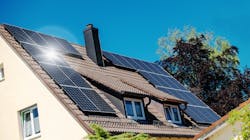Australian Govt. Funds University Study on Rooftop Solar and DER in Contingencies
On behalf of the Australian Government, the Australian Renewable Energy Agency (ARENA) has recently announced $A981,000 in funding to the University of New South Wales (UNSW) to develop a number of tools to better understand the behaviour of rooftop solar and distributed energy resources (DER) in response to a variety of contingency events across the National Electricity Market (NEM).
The $A2.1 million project will look to identify how these assets respond to contingency events such as the sudden loss of a large generator or transmission line, while also assessing opportunities for DER and rooftop solar PV to further protect the NEM from such events in the future.
The study will improve data capture, assess inverter behavior, inform the development of new standards and set up tools and frameworks for long term monitoring of solar and DER asset behavior.
The Australian Energy Market Operator (AEMO) and solar monitoring company Solar Analytics are also partnering on the UNSW project.
As part of the study, the UNSW will assess inverter compliance rates, identify possible improvements to existing inverter standards and provide the AEMO with new tools to more effectively operate a safe, secure and reliable power system with high levels of rooftop solar in the grid.
To maintain power system security in the NEM, the AEMO must consider a range of contingency events. The system needs to withstand these contingency events and quickly return to its regular secure operating conditions.
The AEMO’s Renewable Integration Study has identified that high penetration of rooftop solar presents challenges to power system security and that the impacts of it are already occurring and are expected to increase over the next five years.
Once developed, the UNSW’s tools have the potential to help address many of the recommendations made in the Renewable Integration Study, such as informing the refinement of technical performance standards and establishing real-time visibility of rooftop solar and DER assets.
ARENA CEO Darren Miller said UNSW’s project was a great opportunity to understand how rooftop solar reacts in contingency events and how it can be improved upon.
“UNSW’s project is an exciting step in developing the vital components for rooftop solar and DER and the benefits they bring to supporting the electricity grid. Integrating renewables into the electricity system is a key priority for ARENA, so the tools being developed throughout the project will help to ensure that Australia’s record-breaking solar installations continue to be of benefit to the grid and in helping with system security,” said Miller.
